Step by Step on The Way of Saint James
From Barbadelo to Gonzar
8 June 2018
Stage 29 – 26 km

If I were to follow the classic stages marking the French route of The Way, today’s itinerary, which is predominantly downhill, would only be about eighteen kilometres long. Tomorrow’s stage, however, with its continuous ups and downs, would amount to approximately forty kilometres.
After a quick evaluation, it seems appropriate to rebalance the two routes by opting for an average total length. Therefore, I extend today’s stage to twenty-six kilometres, finishing in Gonzar, and reduce tomorrow’s to thirty-two kilometres, making it slightly less demanding.
The decision is made quickly, especially since Rocco agrees and there are no other people leaving with us this morning.
We set out at 7:00, a little later than our starting times in the past few days.
The reason for the delay is the breakfast we have at the accommodation where we stayed overnight. As one might imagine, sitting comfortably at a table for the first meal of the day takes more time than grabbing something on the go. At least for today, we allow ourselves this small luxury since breakfast is included in the price.
As we leave Barbadelo, the same cows we saw returning to the stable yesterday are already lying down on the grass at this early hour.
The black and white patches of their coats, typical of Holstein cows, add tones and contrast to the naïve landscape, where green dominates.
As we pass by, the friendly animals remain unfazed, gazing at us with a look that mixes drowsiness, indifference, and curiosity.
The weather is cold, and there is the usual mist.
A few drops of rain greet us, but we are not intimidated for now and leave the poncho in the backpack.
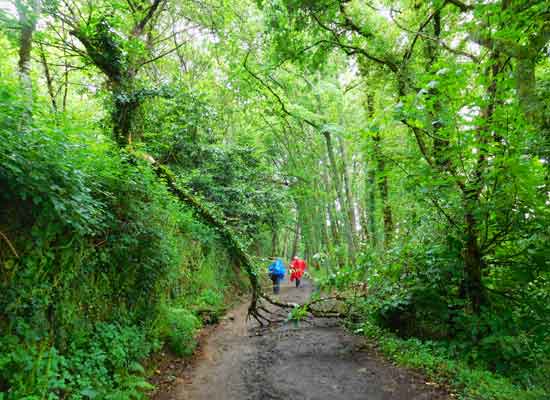
With our muscles still cold, the very first part of the route, slightly uphill, makes us struggle a little.
The roads busy with roaring motor vehicles are far from the path we are following, and once again, we can fully enjoy the lush nature of Galicia.
The alternation between dense, impenetrable forests and vast open fields reveals new and surprising natural settings at every step.
Walking through these landscapes is an explosion of sensations that reach the soul through the senses: the smell of humid air infused with tree fragrances; the touch of moss, dense and soft, widespread on trunks and rocks; the sound of leaves crunching underfoot; the sight of streams, whose waters flow slowly but steadily towards the sea.
We cross several bridges, some made of ancient stone and others, more decrepit, are simple wooden walkways.
In these areas, human presence is limited to tiny hamlets made up of a few slate-built rural houses.
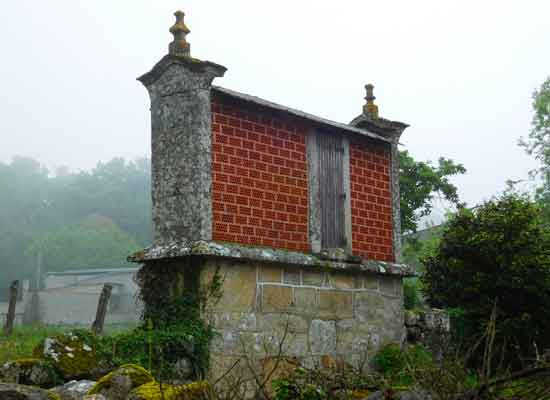
Here in Galicia, near houses and farms, one often sees peculiar stone constructions that are characteristic of the region.
They are called “hórreos,” and they are nothing more than storage spaces for hay and grains.
Their shape resembles a tall, narrow parallelepiped with slits along the side walls forming a kind of grid; this feature allows air to circulate inside and keep the contents dry.
Like stilt houses, the “hórreos” are raised above the ground. This way, the stored products are protected both from moisture and rodents.
There are many of these structures, and they all look quite similar in shape.
The differences between them lie in their size, the material used, and the level of refinement—features that reflect the owner’s standard of living. Some “hórreos” are very simple and rough, while others are finely crafted with noble stones.
At first glance, to our untrained eyes, the “hórreos” looked like small votive chapels due to the crosses and other religious symbols placed on their sloping roofs.
***
It is 9:15 when we pass through Ferreiros.
Leaving the village, we walk past the igrexa de Santa María de Mirallos, a small church adorned with a beautiful Romanesque portal.
The building, originally located in the neighbouring village, was moved here in 1790, dismantled and reassembled stone by stone, respecting its original 12th-century architecture.
Along the route, milestone after milestone marks the kilometres remaining to Santiago de Compostela.
The number gradually decreases as we advance, almost like a countdown before the New Year or a rocket launch: – ten; nine; eight; seven... –
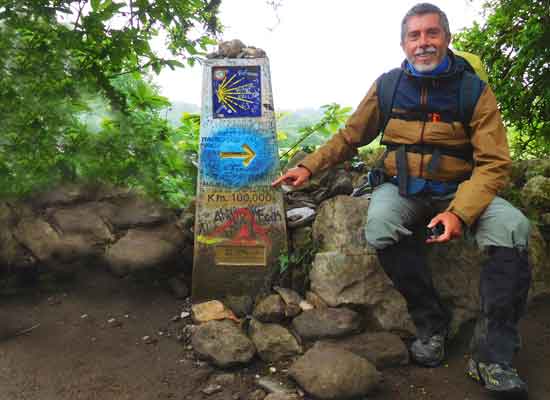
About ten minutes after Ferreiros, we reach the milestone that marks exactly 100 kilometres to the final destination.
This is also a very rewarding moment, both for the many efforts we have made to get here and for how close we are to completing The Way.
To celebrate this achievement, we take the customary photo next to the marker.
The stop lasts only a few minutes, and we immediately set off again.
The two-digit number I now see on the milestones gives me even more energy to keep going, especially when I think back to the road sign at the exit of Roncesvalles, which read 790 kilometres to Santiago de Compostela.
From Ferrerios onwards, the path descends continuously to Portomarín, with beautiful natural landscapes continuing to define The Way.
A few kilometres apart, we come across several small rural settlements.
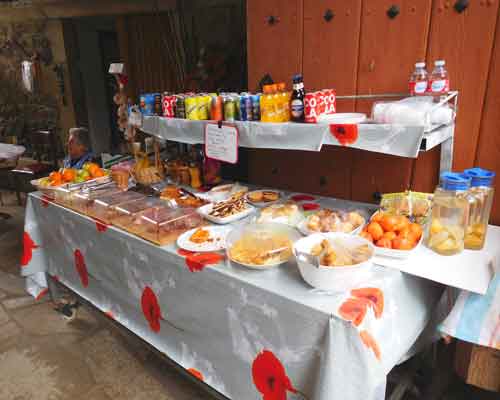
We come across a small unattended stall just before As Rozas, positioned in front of a house. On display, there are various small food items: brioches, yogurt, boiled eggs, fruit, drinks, and more.
There is no one supervising or checking what passers-by take freely.
Only a small sign reminds visitors of their responsibility, bearing the words: “No es gratis, es donativo.”
As usual, it’s a free choice—those who take something leave a donation of their choice.
A little further ahead, we find another refreshment point dedicated to travellers on The Way. This time, however, it is set up in the hallway of a large manor house.
Here, the hospitality is even better organized.
In addition to packaged goods, the women of the house often prepare dishes using local and organic ingredients: “empanada,” “caldo gallego,” tortilla, and crêpes. They also frequently slice various types of delicious cured meats.
For the pilgrims, there are chairs available to rest for a few minutes and a bathroom for those in need. Smiles and kindness are generously offered to all walkers.
Of course, even in this case, there are no fixed prices, but the usual “donativo” is openly expected.
It is precisely noon when we arrive in Portomarín.
Despite our decision not to end today’s stage here and to continue to Gonzar, we still want to have a look around the town.
Portomarín has nearly two thousand inhabitants and includes some historically significant monuments.
The old town, made up of medieval villages, was submerged when the Belesar dam was built in 1962. Before this happened, the most important buildings were saved: dismantled stone by stone and rebuilt in the new town, which was constructed on a hill not far from the original site.
During drier seasons, when the dam’s water level drops, the upper parts of some of the ancient buildings can be seen emerging.

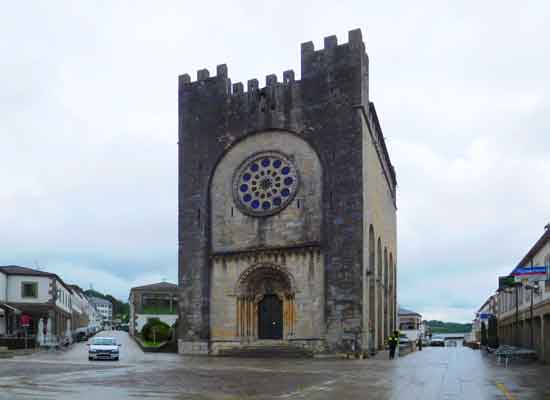
To enter Portomarín, we cross the long modern bridge over the Río Miño. Immediately after, a long and steep granite staircase leads to the capilla de a Virxe das Neves.
The chapel was built using the only arch preserved from the old medieval bridge, while the other arches of the historic structure were lost during the dam’s construction.
Reaching the town centre, we find ourselves in the Praza Conde Fenosa, where the igrexa de San Nicolás is located.
This religious building, once belonging to the Order of Saint John of Jerusalem, has the appearance of a fortress with a square, almost cubic shape, and is one of the most impressive Romanesque structures in all of Galicia.
The austere façade is highlighted by a richly decorated entrance portal and a rose window above with geometric patterns.
Inside, the church consists of a single nave with a barrel vault and a semicircular apse.
Next, we see the igrexa de San Pedro.
This church, dating back to the 10th century, has retained its Romanesque style even after being relocated from the old Portomarín to its current position.
As we leave the town, we meet Giovanna and Amandine.
Both are determined to stop here in Portomarín, but after speaking with me and Rocco, they change their minds and decide to continue walking with us.
Outside Portomarín, nature once again becomes the absolute protagonist of our journey along The Way towards Santiago de Compostela.
These last eight kilometres are uphill. Between Portomarín and Gonzar, there is an elevation gain of about 150 metres.
Shortly after leaving the town, the rain starts falling again and stays with us for most of this stretch.
After covering the twenty-six kilometres of today’s itinerary, we arrive in Gonzar at 15:00.
During this stage, we notice a greater presence of pilgrims: the flow of people walking has increased significantly due to those who start from Sarria to complete the last hundred kilometres.
According to statistics, they represent almost one-third of the 330,000 pilgrims who walk to Santiago de Compostela every year.
As a result, accommodations are also more crowded in this final part of the French route.
Here in Gonzar, we find a place without any problems. This is a small intermediate location that pilgrims rarely consider for an overnight stay.
We stay at the Refugio of the Xunta de Galicia, the municipal hostel with only twenty-eight beds.
Apart from this, there is just one other accommodation option in the area—the private Albergue Casa Garsia, which can host up to forty people.
Once we reach our destination, we carry out the usual post-stage activities. While waiting for the laundry cycle to finish, we enjoy an aperitif in a bar near the hostel with other pilgrims.
While it pours outside, laughter and multilingual conversations warm the atmosphere and help fill the emptiness around us.
The usual afternoon sightseeing stroll, which we take as soon as the rain stops, confirms that this is yet another village that barely exists. The only monument worth a minimum of attention is the small Baroque church dedicated to Santa María de Gonzar.
In the evening, we have dinner at Casa Garcia, where the “pilgrim’s menu” costs 10 Euros.
For the first course, I have another lentil soup. I then continue with a nice grilled salmon steak and finish with a slice of homemade ice cream cake.
| © Aldo Lardizzone 2020 |  |
CREATIVE COMMONS |



